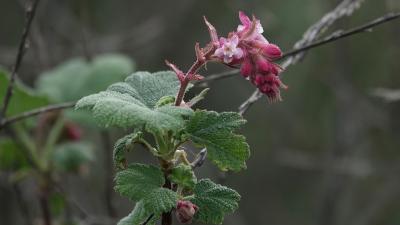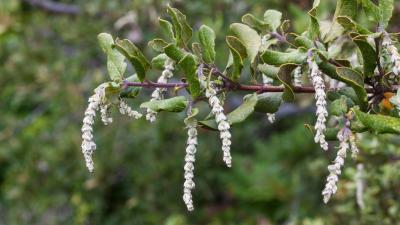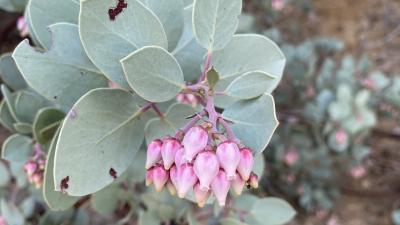We often think of winter as a time for rest. A quiet moment of dormancy spent in preparation for what’s to come - spring arrives with a vibrant burst of wildflowers, summer carries the fragrant scent of blue elder blossoms and berries then autumn, with its changing colors and cool air, leaves acorns scattered across the forest floor.
Yet for some California native plants, winter is their time to shine. Well adapted to historically mild winters, these plants provide welcome splashes of color across our landscape and can be a staple food source for migrating and resident animals.
Check out the list below of some of the wonderful winter bloomers in our region and where you may be able to spot them.
Chaparral Currant (Ribes malvaceum)

Chaparral currant is endemic to California, where it grows along the slopes of coastal and foothill ranges near manzanita, madrone and bay laurel. A member of the gooseberry family, Ribes malvaceu, has fragrant pink flowers that are known to attract native bees and hummingbirds. The flowers bloom from November to March, then begin developing their edible fruit that is favorited by birds.
You can spot these rose-colored blooms in Fremont Older Open Space Preserve this winter.
California Gooseberry (Ribes californicum)

California gooseberry, Ribes californicum, is a close relative of chaparral currant and fellow endemic species with charismatic flowers and edible fruit. Also commonly referred to as Hillside Gooseberry, the red and white flowers hang like lanterns from the shrub’s branches with the red sepals reflexed upward to form a crown.
Unlike currants, gooseberry plants develop large, half inch spines along the stems in an attempt to prevent predation from wildlife. The flowers bloom in early winter and produce red berries also covered in many, small spines.
These plants can be seen growing on the eastern slope of the Santa Cruz Mountains in Monte Bello and Los Trancos open space preserves.
Coast Silktassel (Garrya elliptic)

The flowers of the coast silktassel, Garrya elliptic, take on a unique form and appearance. As a dioecious species, the coast silktassel develops separate male and female flowers which cluster into a narrow spike referred to as a catkin. The female catkins are 2-3 inches in length and silver-gray while the showy gray-green male flowers can reach up to 12 inches.
You can spot these blooming in late winter along Wildcat loop trail in Rancho San Antonio County Park & Open Space Preserve.
Please note, parking at Rancho San Antonio can often fill up on weekends and other busy times. Check parking availability using the online space counter. Biking, walking and using public transportation is encouraged.
Big Berry Manzanita (Arctostaphylos glauca)

Manzanita species are widespread throughout California chaparral and woodlands. True to its common name, big berry manzanita, Arctostaphylos glauca produces the largest edible fruit of any manzanita species. The white and pink urn-shaped flowers begin to bloom in early winter and by April produce edible red berries.
Although manzanitas, with their characteristic peeling red bark, can be spotted in many Midpen preserves, Sierra Azul Open Space Preserve supports a wide diversity of species, include the big berry manzanita.
Redwood Violet (Viola sempervirens)

The lemon-yellow flowers of the redwood violet, Viola sempervirens, can be spotted in shady coastal forests of the west coast from February through July. Like other violets, this low growing, perennial herb has rounded, heart shaped leaves and thrives in the damp canopy understory. The purple-brown stipes on the flower petals direct pollinators and are referred to as nectar guides.
These plants can be seen in Purisima Creek Redwoods Open Space Preserve.

